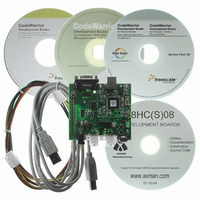DEMO9S08EL32 Freescale Semiconductor, DEMO9S08EL32 Datasheet - Page 216

DEMO9S08EL32
Manufacturer Part Number
DEMO9S08EL32
Description
BOARD DEMO FOR 9S08 EL MCU
Manufacturer
Freescale Semiconductor
Type
MCUr
Datasheets
1.DEMO9S08EL32.pdf
(356 pages)
2.DEMO9S08EL32.pdf
(14 pages)
3.DEMO9S08EL32.pdf
(2 pages)
Specifications of DEMO9S08EL32
Contents
Evaluation Board
Processor To Be Evaluated
MC9S08EL32
Data Bus Width
8 bit
Interface Type
RS-232, USB
Operating Supply Voltage
12 V
Silicon Manufacturer
Freescale
Core Architecture
HCS08
Core Sub-architecture
HCS08
Silicon Core Number
MC9S08
Silicon Family Name
S08EL
Rohs Compliant
Yes
For Use With/related Products
MC9S08EL32
Lead Free Status / RoHS Status
Lead free / RoHS Compliant
- Current page: 216 of 356
- Download datasheet (9Mb)
12.6.9.3
The transmit abort bit (TXABRT) in SLCC1 allows the user to cease transmission of data on the next byte
boundary. When this bit is set to 1, it will finish transmitting the byte currently being transmitted, then
cease transmission. After the transmission is successfully aborted, TXABRT will automatically be reset
by the SLIC to 0. If the SLIC is not in process of transmitting at the time TXABRT is written to 1, there is
no effect and TXABRT will read back as 0.
12.6.9.4
Possible errors on request message data are:
12.6.10 Handling IMSG to Minimize Interrupts
The IMSG feature is designed to minimize the number of interrupts required to maintain LIN
communications. On a network with many slave nodes, it is very likely that a particular slave will observe
messages which are not intended for that node. When the SLIC module detects any message header, it
synchronizes to that message frame and bit rate, then interrupts the CPU after the identifier byte has been
successfully received and parity checked. At this time, if the software determines that the message may be
ignored, IMSG may be set to indicate to the module that the data field of the message frame is to be ignored
and no additional interrupts should be generated until the next valid message header is received. The bit is
automatically reset to 0 after the current message frame is complete and the LIN bus returns to idle state.
This reduces the load on the CPU and allows the application software to immediately begin performing
any operations which might otherwise not be allowed while receiving messaging.
218
•
•
•
Byte Framing Error
Checksum-Error (LIN specified error)
Bit-Error
Transmit Abort
Possible Errors on Request Message Data
Do not write the CHKMOD or data length values in SLCDLC more than
one time per message frame. The SLIC tracks the number of sent or received
bytes based on the value written to this register at the beginning of the data
field and rewriting this register will corrupt the checksum calculation and
cause unpredictable behavior in the SLIC module. The application software
must track the number of sent or received bytes to know what the current
byte count in the SLIC is. If programming in C, make sure to use the
STATIC modifier on this variable (or make it a global variable) to ensure
that it keeps its value between interrupts.
IMSG will prevent another interrupt from occurring for the current message
frame, however if data bytes are appearing on the bus they may be received
and copied into the message buffer. This will delete any previous data which
might have been present in the buffer, even though no interrupt is triggered
to indicate the arrival of this data.
MC9S08EL32 Series and MC9S08SL16 Series Data Sheet, Rev. 3
NOTE
NOTE
Freescale Semiconductor
Related parts for DEMO9S08EL32
Image
Part Number
Description
Manufacturer
Datasheet
Request
R
Part Number:
Description:
Manufacturer:
Freescale Semiconductor, Inc
Datasheet:
Part Number:
Description:
Manufacturer:
Freescale Semiconductor, Inc
Datasheet:
Part Number:
Description:
Manufacturer:
Freescale Semiconductor, Inc
Datasheet:
Part Number:
Description:
Manufacturer:
Freescale Semiconductor, Inc
Datasheet:
Part Number:
Description:
Manufacturer:
Freescale Semiconductor, Inc
Datasheet:
Part Number:
Description:
Manufacturer:
Freescale Semiconductor, Inc
Datasheet:
Part Number:
Description:
Manufacturer:
Freescale Semiconductor, Inc
Datasheet:
Part Number:
Description:
Manufacturer:
Freescale Semiconductor, Inc
Datasheet:
Part Number:
Description:
Manufacturer:
Freescale Semiconductor, Inc
Datasheet:
Part Number:
Description:
Manufacturer:
Freescale Semiconductor, Inc
Datasheet:
Part Number:
Description:
Manufacturer:
Freescale Semiconductor, Inc
Datasheet:
Part Number:
Description:
Manufacturer:
Freescale Semiconductor, Inc
Datasheet:
Part Number:
Description:
Manufacturer:
Freescale Semiconductor, Inc
Datasheet:
Part Number:
Description:
Manufacturer:
Freescale Semiconductor, Inc
Datasheet:
Part Number:
Description:
Manufacturer:
Freescale Semiconductor, Inc
Datasheet:










